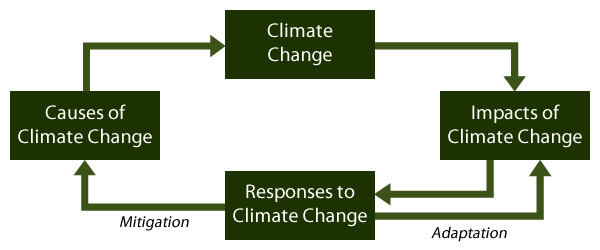Course Author
Brandi Robinson
Associate Teaching Professor
Department of Energy and Mineral Engineering
College of Earth and Mineral Sciences
The Pennsylvania State University
Overview
GEOG 438W is a writing-intensive course that concentrates on the human-environment interactions which have created and respond to global climate change. Geography 438W is a required course for the Energy and Sustainability Policy major.
This semester, we're going to look more closely at all angles of the human-climate interface. We need to understand how the problem is happening in the first place and then what impacts that problem creates before we can figure out how to solve it.
- Unit 1 is all about where we are with climate change currently. We'll take a close look at how we got here and how we might change course as well.
- Unit 2 will show us where it's going and how that changing climate is manifesting in ways that have impacts. Climate change isn't about polar bears drifting sadly on little chunks of ice. (Of course, it CAN be about the bears if you want it to be.) Instead, climate change is about impacts on our health, our ability to grow food, our access to clean and plentiful drinking water, our weather, our ecosystems. But we'll also look at how we can become more resilient and adapt to the changes we're facing.
- Unit 3 will give us the chance to imagine where we want to be. We'll look at climate futures and what it means to be sustainable. We'll think about the role of our own thoughts, opinions, and actions in addressing this planetary challenge.

This is a flow chart describing how people interact with the climate system."Climate change" leads to "Impacts of Climate Change"."Impacts of Climate Change" lead to "Responses to Climate Change". "Responses to Climate Change" either leads back to "Impacts of Climate Change" (labeled as "Adaptation") or it leads to "Causes of Climate Change" (labeled Mitigation). "Causes of Climate Change" leads back to "Climate Change".
This framework shows how people interact with the climate system. Starting on the left-hand side, human activities, such as land clearing and fossil fuel burning, put heat-trapping greenhouse gases into the atmosphere, thereby changing the atmosphere’s composition, increasing the so-called greenhouse effect, and warming the near-surface layers of the atmosphere. These human activities are therefore causing climate change (top center), which has many characteristics beyond surface warming, including increased evaporation, changed rainfall quantity, intensity, and location, decreased ice and snow cover, and increased sea level among others. These climate changes have impacts on physical systems, biological systems, and human systems (right-hand side), with most of these impacts being negative. People respond to these impacts in two ways (bottom), either through mitigation or adaptation. Mitigation aims to reduce or eliminate the causes of climate change; adaptation seeks to reduce or eliminate the impacts. Together, the impacts of and responses to climate change make up the total consequences of climate change. We will expand on the human causes and consequences of climate change later in this lesson and later in this course.
The human dimensions of climate change shown interact at all scales of the climate system and human activity. The human causes of climate change result from billions of daily local actions––such as emissions of carbon dioxide from fossil fuel combustion and forestry––that accumulate to cause a change of global climate. This global-scale change plays out differently in different regions, warming most areas while wetting some areas and drying others. These regional climate changes lead to local impacts that have more or less severity depending on the vulnerability of each place’s natural and human systems. Responses vary, too, with local, regional, and global efforts both to mitigate greenhouse gas emissions and adapt to climate change.
Topics of Study
| Unit | Components of Unit | |
|---|---|---|
| Unit 1: Where we are |
Lesson 1: The Science of Climate Change Lesson 2: Emissions by Sector Lesson 3: Planetary Impacts Unit 1 Project Writing |
|
| Unit 2: Where it's going |
Lesson 4: Vulnerability Lesson 5: Impacts on Places Lesson 6: Impacts on People Lesson 7: Sustainability Unit 2 Project Writing |
|
| Unit 3: Where we want to be |
Lesson 8: Public Opinion on Climate Change Lesson 9: Individual Behavior and Collective Action Lesson 10: Mitigation Lesson 11: Adaptation Unit 3 Project Writing Lesson 12: Storytelling Back to the Future |
|

This course is offered as part of the Open Educational Resources initiative of Penn State's Dutton Institute. You are welcome to use and reuse materials that appear in this site (other than those copyrighted by others) subject to the licensing agreement linked to the bottom of this and every page.
Students who register for this Penn State course gain access to assignments and instructor feedback, and earn academic credit. Information about Penn State's Energy and Sustainability Policy Bachelor's program is available at the ESP Overview Page.
